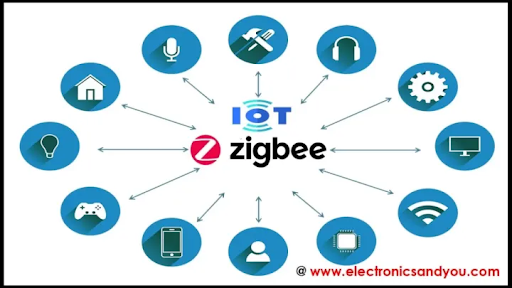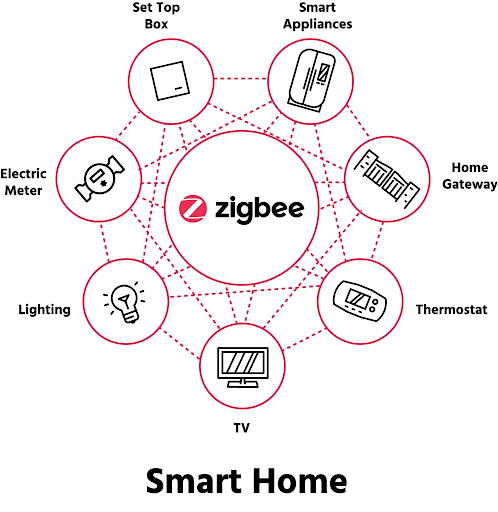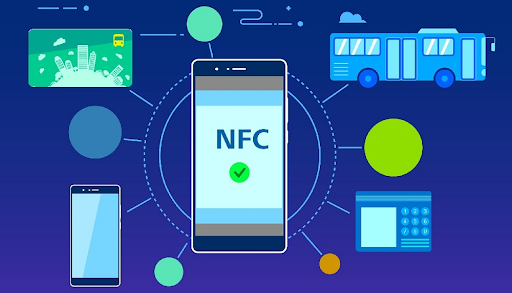Introduction to Zigbee and Application Solutions
1. Introduction to Zigbee
Zigbee is a wireless communication protocol based on the IEEE 802.15.4 standard, specially designed for IoT (Internet of Things) applications with criteria for energy efficiency, low latency, and high scalability. Zigbee operates primarily on the 2.4GHz band (with 868MHz available in Europe and 915MHz in the US), with a mesh network mechanism that helps devices communicate effectively even in complex environments.
Key features of Zigbee:
- Mesh network: Zigbee devices can communicate through a mesh network model, allowing for expanded connection range and increased reliability.
- Low energy consumption: Devices can operate for many years on a small battery.
- Good scalability: A Zigbee network can support up to 65,000 devices.
- High security: Uses AES-128 encryption to protect data.
- Easy integration: Compatible with many smart home systems and popular IoT platforms such as SmartThings, Home Assistant.
Thanks to these advantages, Zigbee is widely applied in smart homes, industrial automation, energy management, and energy-efficient IoT solutions.

2. Zigbee in Smart Homes – Home Automation Solutions
Zigbee plays an important role in connecting and automating smart home devices, providing convenience, safety, and energy savings.

2.1. Smart Lighting Systems
- Zigbee smart lights can adjust brightness, change colors in real-time, or according to pre-programmed contexts.
- Remote control via mobile applications or virtual assistants like Google Assistant, Amazon Alexa, Apple HomeKit.
- Combined with light sensors to automatically turn lights on/off based on environmental conditions.
2.2. Smart Sensors and Switches
- Zigbee motion sensors help automatically turn on lights when someone moves into the area.
- Temperature and humidity sensors can activate air conditioning or ventilation fans when needed.
- Zigbee smart switches allow remote control of devices without changing the home's electrical system.
2.3. Security Systems
- Door sensors, motion sensors, and Zigbee cameras help detect intruders.
- Zigbee alarms can activate warning sounds or send notifications to phones.
- Smart lock systems support unlocking via fingerprint, PIN code, or remote control.
3. Comparing Zigbee with Z-Wave – Which Technology is More Suitable?
Zigbee and Z-Wave are two popular communication protocols in smart homes. Below are the differences between these two technologies:
| Criteria | Zigbee | Z-Wave |
| Frequency Band | 2.4GHz (global) | 868MHz (EU), 908MHz (US) |
| Transmission Speed | 250 kbps | 100 kbps |
| Range | ~10-30m (with mesh) | ~30-100m (with mesh) |
| Power Consumption | Very low | Low |
| Scalability | 65,000 devices | Maximum 232 devices |
| Interference Resistance | Lower due to 2.4GHz | Higher due to dedicated frequency band |
When to choose Zigbee?
- When you need to connect many devices in a network.
- When you want compatibility with various systems and brands.
When to choose Z-Wave?
- When you need stable connections in environments with less signal interference.
- When you need longer transmission distances without repeaters.
4. Zigbee in Industrial Automation – Practical Applications
Zigbee is also strongly applied in the industrial sector, helping to connect sensors and control devices intelligently.
4.1. Device Monitoring and Control
- Zigbee sensors monitor temperature, humidity, pressure, and vibration in factories.
- Remote control of HVAC systems, industrial fans, and production equipment.
4.2. Energy Management
- Zigbee helps optimize electricity consumption by monitoring and adjusting device operations.
- Supports integration with Energy Management Systems (EMS) to save operational costs.
4.3. Predictive Maintenance
- Analysis of sensor data helps early detection of technical faults.
- Reduces downtime and improves device lifespan.
5. Security in Zigbee Systems – Vulnerabilities and Solutions
5.1. Common Security Risks
- Man-in-the-Middle (MITM) attacks: Hackers can intercept and fake data.
- Device spoofing: Attackers can add strange devices to the network.
- Weak encryption: If not properly configured, Zigbee can be exploited.
5.2. Solutions to Enhance Security
- Use strong AES-128 encryption.
- Regular firmware updates.
- Establish a whitelist of permitted devices.
6. Zigbee Green Power – Energy-Saving Solution for IoT
6.1. Operating Mechanism
- Zigbee Green Power (ZGP) allows devices to operate without batteries by using energy harvested from the environment.
6.2. Practical Applications
- Wireless switches powered by energy from button presses.
- Environmental sensors can harvest energy from light or vibration.
Conclusion
Zigbee is an important technology in IoT, especially in smart homes and industry. The choice between Zigbee and Z-Wave depends on specific usage needs. With the development of Zigbee Green Power, IoT devices are becoming increasingly energy-efficient and more environmentally friendly.



